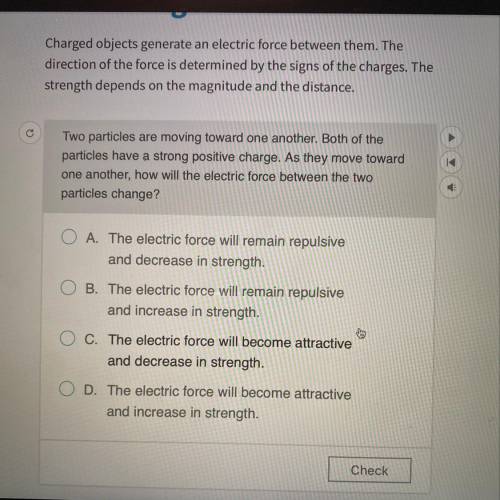Two particles are moving toward one another. Both of the
particles have a strong positive char...

Physics, 05.05.2020 04:26 letsgetcookingblog
Two particles are moving toward one another. Both of the
particles have a strong positive charge. As they move toward
one another, how will the electric force between the two
particles change?
A. The electric force will remain repulsive
and decrease in strength.
O
O
B. The electric force will remain repulsive
and increase in strength.
C. The electric force will become attractive
and decrease in strength.
D. The electric force will become attractive
and increase in strength.
O


Answers: 1


Other questions on the subject: Physics

Physics, 22.06.2019 12:30, madlenserlipepu1o
Hydrogen atoms are excited by a laser to the =4n=4 state and then allowed to emit. what is the maximum number of distinct emission spectral lines (lines of different wavelengths) that can be observed from this system? 8 6 2 7 4 5 1 3 calculate the wavelength of the 4⟶14⟶1 transition. =λ=
Answers: 2


Physics, 22.06.2019 18:30, ayoismeisalex
Both speed and velocity measure how fast something is moving. however, since speed is not a it does not require a(n question 6 options: a) quantity , unit b) magnitude, unit c) scalar, direction d) vector, direction
Answers: 2

Physics, 23.06.2019 03:20, marshaehayes9444
Neutrons are placed in a magnetic field with magnitude 2.30 t. part a part complete what is the energy difference between the states with the nuclear spin angular momentum components parallel and antiparallel to the field? δe δ e = 2.77×10−7 ev previous answers correct part b part complete which state is lower in energy: the one with its spin component parallel to the field or the one with its spin component antiparallel to the field? which state is lower in energy: the one with its spin component parallel to the field or the one with its spin component antiparallel to the field? parallel antiparallel previous answers correct part c part complete how do your results compare with the energy states for a proton in the same field (δe=4.05×10−7ev)? how do your results compare with the energy states for a proton in the same field this result is smaller than but comparable to that found in the example for protons. this result is greater than but comparable to that found in the example for protons. previous answers correct part d the neutrons can make transitions from one of these states to the other by emitting or absorbing a photon with energy equal to the energy difference of the two states. find the frequency of such a photon. f f = mhz previous answersrequest answer incorrect; try again; 5 attempts remaining
Answers: 2
You know the right answer?
Questions in other subjects:


Mathematics, 29.01.2020 18:46



Mathematics, 29.01.2020 18:46

Chemistry, 29.01.2020 18:46



Mathematics, 29.01.2020 18:46

Mathematics, 29.01.2020 18:46



